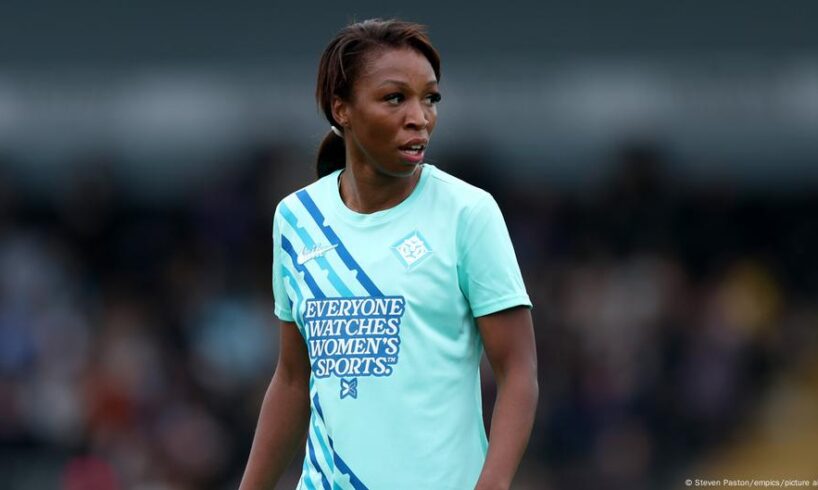
When the league stage of the UEFA Women’s Champions League begins on October 7, it will do so without the game’s most expensive player. France midfielder, Grace Geyoro, signed for newly-promoted London City Lionesses (owned by wealthy businesswoman and serial football investor, Michelle Kang) in September for a fee of about €1.6 million ($1.9 million).
Geyoro’s move was the fifth to break the world transfer record in 2025, with each player moving to either the NWSL in the USA or the WSL in England.
“It is a very good sign,” women’s football agent Jasmina Covic told DW.
“The record is being broken every couple of months. It’s good for the ecosystem. If I look back 10 years, there were just a few transfers with any fees, now you see it all the time.”
Short-term contracts and a lack of investment in women’s football meant that transfer fees for players were very rare until recently and, in comparison to men’s football, very small. Until Pernille Harder’s €280,000 move from Wolfsburg to Chelsea in 2019, €235,000 was the top fee paid for a female player. That record had stood since 2002.
Rising transfer fees may leave some behind
The success of recent women’s international tournaments and increasingly common sellouts at significant stadiums around the world have increased the sports’ visibility and, accordingly, marketability.
A report by Nielsen Sports in collaboration with PepsiCo released earlier this year claimed it is set to become one of the world’s top five sports by 2030 and watched by more than 800 million people. With more money flowing in to the best players and the biggest clubs, transfer fees and wages at the top end have increased accordingly. While larger commercial deals, longer more lucrative contracts, higher ticket receipts and broadcast deals all look good for the elite, there are dangers associated with the rapid growth.
High profile tournaments like Euro 2025, won by England, have raised the profile of women’s footballImage: Stefan Wermuth/REUTERS
“As you start bringing in these huge transfer fees, you’re eliminating so many of the clubs from these different leagues around the world who can’t afford these players, and then you’re just making that gap a lot bigger,” Shona Young, of global sports marketing agency SPORTFIVE, told DW.
That gap between the haves and have nots is already a concern for many in women’s football, just as in men’s. No club from outside England, France, Germany or Spain have won the Women’s Champions League in Europe while domestic titles are often won by the same team over and over again. Though leagues in Mexico, Brazil and other parts of the world are also growing rapidly, there’s little doubt that the leagues in England and the USA are where the top players want to be.
Bundesliga has revenue problem
All of which poses a problem for the Bundesliga in Germany, as Covic notes.
“The German market is still very interesting, it’s a very competitive league and more investments are being made. But obviously, you can’t compare it to England and the US, where there’s much more money. But I think we’re getting there slowly.”
No German side has won the Champions League since FFC Frankfurt (now part of Eintracht Frankfurt) in 2015, when the landscape was very different. The record fee for a player in the Bundesliga is German midfielder Lena Oberdorf’s 2024 move from one of the leagues major powers, Wolfsburg, to the other, Bayern Munich. The cost was €450,000, much less than a third of Geyoro’s price.
Bayern Munich have won the last three Bundesliga titles but have never got past the quarterfinals of the Champions LeagueImage: Beautiful Sports/IMAGO
According to a report from SPORTFIVE, where Young works, Germany’s top flight gets €5.2 million a year from broadcasting income and €5.5 million from its title sponsor. By comparison, the WSL makes €15 million in broadcasting and more than €17 million from its title sponsor. The NWSL make even more, €50 million for broadcasting and a reported €20 million from its sponsor. That, plus higher average attendances and richer owners (whether men’s clubs or individuals), explains the gap in transfer budget.
Women’s football fans follow players, not clubs
These are not the only metrics on which the Bundesliga is falling behind, with social media following of leagues, clubs and players also lagging by comparison. For Young, the interest in players and national teams are key to attracting new fans. The report surveyed 12,000 people with various levels of interest in the game. It found, as of January, that Germany’s most popular player Giulia Gwinn, had 632,000 Instagram followers compared to 1.1 million for England captain Leah Williamson and 9.9 million for Alex Morgan, of the USA. Germany’s national team had 468,000 followers, England 2.3 million and the US also 2.3 million.
“What we found in women’s football is the fans want to follow the players before they follow a club. So they really latch on to these national team players and really support them, find out what club they’re playing at and then gravitate to support that club,” she said. “Whereas in the men’s game, you’ve got hardcore, loyal fans that support the club and the club only, and don’t tend to follow those players.”
Moving for a high transfer fee is another way in which players can attract fans, and therefore finance, added Young. While spending on transfers and wages isn’t the only way to success, it certainly helps. The growth of women’s football has seen rapid change at the very top of the game over the last decade but there is a real danger that other leagues, countries and clubs are in danger of being cut adrift from the elite.
Edited by: Chuck Penfold





